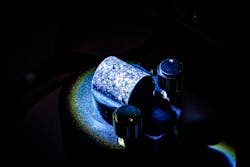New imaging, software better assess 3D-printed metal
A new imaging technique could potentially boost additive manufacturing, simply by better analyzing and assessing the quality of metal alloy parts.
3D-printed metal alloys comprise various microscopic crystals differing in shape, size, and atomic lattice orientation. The new fast, low-cost method, developed by a team at Nanyang Technological University (NTU) in Singapore, allows a better understanding of those properties—among them, strength and toughness.
Matteo Seita, an assistant professor in NTU’s School of Mechanical and Aerospace Engineering and School of Materials Science and Engineering who co-authored the study, explains how the mapping compares to examining wood grain, which is strongest when the grain is continuous in the same direction.
A novel combo
The new optical method performs grain orientation mapping and uses machine learning and “smart software” to measure the crystal orientation from acquired optical signals. A convolutional neural network is used to predict the crystallographic orientation from the optical signal acquired through directional reflectance microscopy (DRM), which is a method that quantifies surface reflectance as a function of illumination angle.
“Currently, it is impossible to tell the difference between good 3D-printed metal parts and the faulty ones unless we assess the material’s microstructure in detail,” Seita says.
With current optical orientation imaging, quality assessment results have been attainable only on pure crystalline solids, and measured optical signals indexed using only material-specific, physics-based models. Expanding beyond such imaging to the area of engineering metal alloys was a challenge, the researchers say, because “the complex, multiphase microstructures of these materials give rise to optical signals that are difficult to decode using physics-based models.”
In their study, published in Computational Materials, the researchers used directed energy deposition—an additive manufacturing process in which focused thermal energy is used to fuse materials by melting as they are being deposited—to produce specimens that exhibited different microstructures. With an optical camera, the microstructure samples were imaged and illuminated from different angles. Some were highly textured, while others appeared finer with randomly oriented grains (see figure).
Such a process for analyzing and assessing 3D-printed metal alloys has, to date, used scanning electron microscopes, which is time-consuming and expensive. This new technique delivers the same information in just minutes, by using machine-learning software also developed by the NTU team and hardware costing only a fraction of those used in current methods.
“Our results demonstrate optical orientation mapping on a metal alloy is achievable,” Seita says. “And since our method is data-driven, it can be easily extended to different alloy systems produced using different manufacturing processes.”
About the Author
Justine Murphy
Multimedia Director, Digital Infrastructure
Justine Murphy is the multimedia director for Endeavor Business Media's Digital Infrastructure Group. She is a multiple award-winning writer and editor with more 20 years of experience in newspaper publishing as well as public relations, marketing, and communications. For nearly 10 years, she has covered all facets of the optics and photonics industry as an editor, writer, web news anchor, and podcast host for an internationally reaching magazine publishing company. Her work has earned accolades from the New England Press Association as well as the SIIA/Jesse H. Neal Awards. She received a B.A. from the Massachusetts College of Liberal Arts.

